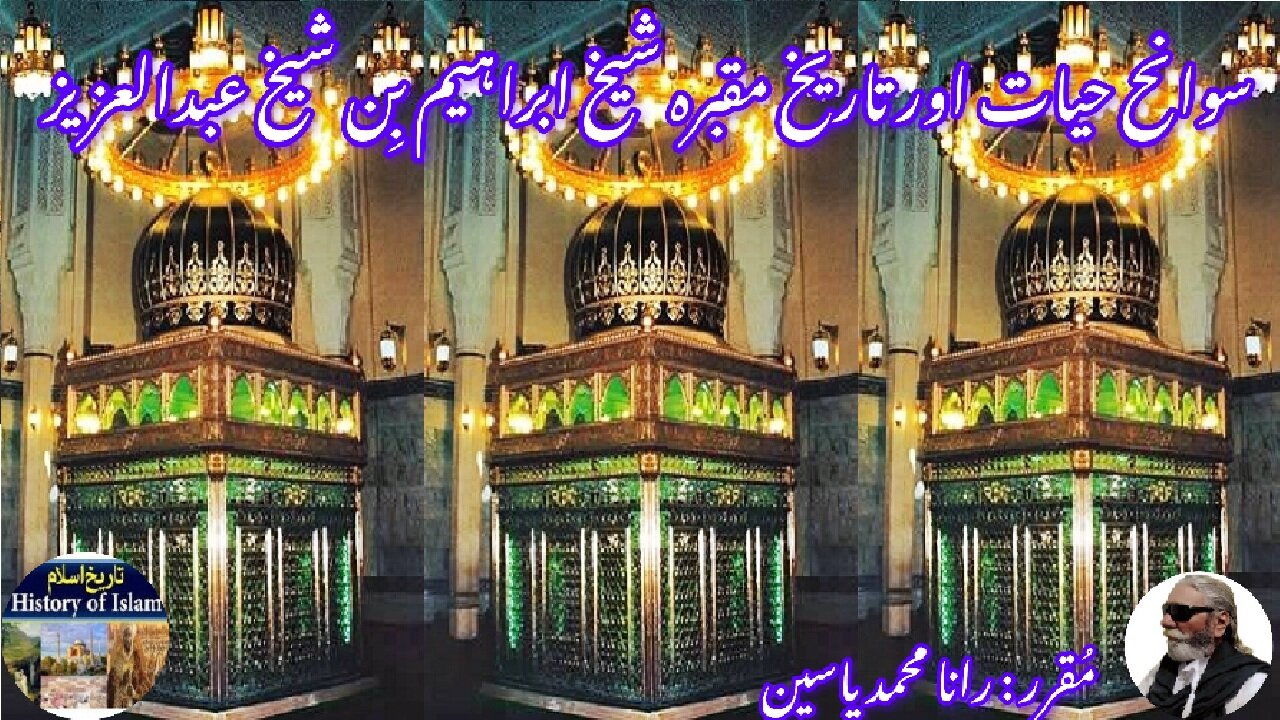Premium Only Content

Shaykh Ibrahim bin Sheikh Abdul-Aziz | شیخ ابراہیم بن شیخ عبدالعزیز کی سوانح عمری اور مزار کی تاریخ
@islamichistory813 #sufisaint #culturalheritage #biography #islamicmysticism #islamicphilosophy #shrine #historicalfigures
Biography of Shaykh Ibrahim bin Sheikh Abdul-Aziz and the history of his shrine
Dekhti Aankhooon aur sountay kaanoon ko Asslamoalaikum, sisters, brothers friends and elders, in informative series videos of Islamic ascolars, sufisaints, cultural heritages, islamic philosophys, islamic mysticisms and historical figures. today we are describing biography of Shaykh Ibrahim bin Sheikh Abdul-Aziz and the history of his shrine.
Shaykh Ibrahim bin Sheikh Abdul-Aziz, known as Abul-Majdi bin Quraish Addasuqi RA, was born in Dasuq-Egypt city on the last night of Shaheban 653H month which coincided with 1255M.
He was born on the eve of Syak, the scholars doubt the emergence of a tsabit month showing the entrance of Ramadan. Shaykh Ibn Harun Asshufi then said: look at this newborn child, does he drink his mother's milk? So his mother replied, "from the time of the call to prayer, he stopped drinking his mother's milk."
Thus Sheikh Ibn Aaron declared that the day was the first day of the month of Ramadan and the signs of the saintliness of Sheikh Ibrahim Addasuqi RA were revealed from the moment of his birth.
He is the fourth and final "Wali Qutub" after Sheikh Ahmad Arrifa'i RA, Sheikh Abdul-Qadir al-Jaelani RA and Shaykh Ahmad al-Badawi RA as believed by the Tashawuf scholars such as Sheikh Mahmud al-Garbawi in his book al-Ayatuzzahirah fi Manaqib al-Awliya 'wal-Aqthab al-Arba'ah, and Assayyid Abul-Huda M.bin Hasan al-Khalidi Asshayyadi in his book Farhatul-Ahbab fi Akhbar al-Arba'ah al-Ahbab and Qiladatul-Jawahir fi fi Zikril Gautsirrifa 'I wa Atba'ihil-Akabir.
He is the founder of the Thariqat known as Burhamiyyah or Dusuqiyyah. His heir as shariq Thariqat Dusuqiyyah Muhammadiyyah of this era is Maulanassyekh Mukhtar Ali Muhammad Addasuqi RA (hopefully long life, amen).
In the book of Thabaqat al-Kubara, you will find Sheikh Abdul-Wahhab Assya'rani RA talking about Sayyidi Abul-Hasan Assyazili's story in 12 pages, Sayyidi Ahmad Arrifa'i in 7 pages, Sayyidi Abdul-Qadir Al-Jailani RA in 9 pages and Sayyidi Ahmad al-Badawi RA in just 7 pages. While Sayyidi Ibrahim Addusuqi RA 25 pages
Shaykh Ibrahim bin Sheikh Abdul-Aziz is one of the most venerated figures in Islamic mysticism, remembered for his spiritual wisdom, deep piety, and tireless efforts in guiding his community toward a path of righteousness. His life story and the subsequent history of his shrine are imbued with profound historical, spiritual, and cultural significance.
Sheikh Abdul-Aziz, was a renowned Islamic scholar and mystic, deeply respected for his knowledge of the Quran and Hadith, as well as his adherence to the Sufi path. Shaykh Ibrahim grew up in an environment rich in spiritual and intellectual pursuits, which profoundly influenced his character and future path.
From a young age, Shaykh Ibrahim displayed an extraordinary aptitude for learning. By the age of ten, he had memorized the Quran and begun studying classical Islamic sciences, including jurisprudence, theology, and Sufism. His early teachers included his father and other prominent scholars in the region, who recognized his prodigious talents and encouraged his intellectual growth.
As Shaykh Ibrahim matured, he sought deeper spiritual understanding. He traveled extensively across the Islamic world, visiting centers of learning in Baghdad, Damascus, Cairo, and Medina. These journeys allowed him to study under some of the greatest scholars and mystics of his time, including those associated with the Qadiriyya and Naqshbandiyya Sufi orders. Shaykh Ibrahim’s teachings synthesized the esoteric wisdom of Sufism with the exoteric practices of Islamic law, emphasizing the importance of balancing inner spiritual development with outward piety.
Central to his teachings was the concept of Tazkiyah (purification of the soul). Shaykh Ibrahim believed that true closeness to Allah could only be achieved through a process of self-purification, which involved regular acts of worship, self-discipline, and sincere repentance. He also stressed the importance of love and compassion, teaching his followers to view every human being as a manifestation of divine mercy.
Shaykh Ibrahim’s charisma and spiritual depth attracted a large following. His disciples included both scholars and laypeople, who were drawn to his ability to explain complex spiritual concepts in simple, relatable terms. He established a Sufi lodge (“zawiya”) in his hometown, which became a center for spiritual instruction and community development.
Beyond his spiritual teachings, Shaykh Ibrahim was deeply committed to social justice and community welfare. He advocated for education, helping to establish schools and libraries in underserved areas. His emphasis on knowledge as a means of empowerment inspired many of his followers to pursue both religious and secular studies.
Shaykh Ibrahim was also a mediator in tribal conflicts, using his wisdom and impartiality to resolve disputes and promote peace. His efforts earned him the respect of leaders and common people alike, further cementing his legacy as a unifying figure in his region.
Shaykh Ibrahim passed away in 1665 at the age of 75. His death was mourned by thousands, and his funeral drew people from across the Islamic world. He was buried in his hometown, and his grave quickly became a site of pilgrimage for those seeking spiritual solace and blessings.
His teachings continued to thrive through his disciples, who preserved and disseminated his works. Many of his written treatises on Sufism, ethics, and theology remain influential to this day, studied by scholars and seekers of knowledge alike.
Shortly after Shaykh Ibrahim’s death, a modest structure was erected over his grave to honor his memory. This initial shrine consisted of a simple dome and a small prayer hall, reflecting the humility and simplicity that characterized his life. Over time, as his reputation as a saintly figure grew, so did the scale and grandeur of the shrine.
In the 18th century, local rulers and wealthy patrons contributed to the shrine’s expansion. A larger mosque was built adjacent to the tomb, and intricate calligraphy and tilework were added to the structure. The shrine became not only a place of worship but also a hub of cultural and intellectual activity, hosting gatherings of scholars, poets, and mystics.
For centuries, Shaykh Ibrahim’s shrine has served as a focal point for spiritual and social life in the region. Pilgrims from across the Muslim world visit the site to pay their respects, seeking blessings and inspiration from the Shaykh’s enduring legacy. Many believe that the shrine possesses a special barakah (spiritual blessing) that can bring healing, guidance, and inner peace.
The shrine has also been a center for charitable activities. Endowments established in Shaykh Ibrahim’s name fund educational programs, medical clinics, and relief efforts for the poor. These initiatives reflect the Shaykh’s lifelong commitment to serving humanity and have helped preserve his legacy of compassion and generosity.
The shrine’s architecture is a stunning blend of Islamic and local styles, symbolizing the universal appeal of Shaykh Ibrahim’s message. The central dome, adorned with intricate geometric patterns and Quranic inscriptions, is a masterpiece of Islamic art. Surrounding the dome are smaller domes and minarets, each bearing unique decorative elements that reflect the region’s artistic heritage.
The interior of the shrine is equally breathtaking. The walls are covered with elaborate mosaics, while the ceiling features intricate woodwork and chandeliers. The tomb itself is enclosed by a beautifully crafted wooden lattice, and pilgrims often leave flowers and other offerings as a sign of devotion.
In recent decades, the shrine has undergone several renovations to accommodate the growing number of visitors. Modern facilities, including rest areas, prayer halls, and a library, have been added to enhance the pilgrim experience. Despite these updates, great care has been taken to preserve the historical and spiritual essence of the site.
The shrine also hosts annual festivals and commemorations, drawing thousands of devotees from around the world. These events feature Quran recitations, Sufi music, and lectures on Shaykh Ibrahim’s teachings, creating a vibrant atmosphere of spirituality and community.
Like many historical and religious sites, Shaykh Ibrahim’s shrine has faced challenges over the years. Political instability, natural disasters, and economic constraints have occasionally threatened its upkeep. However, the local community and international supporters have consistently rallied to protect and preserve this sacred site.
Recent preservation efforts have focused on restoring the shrine’s original features while integrating modern technologies for sustainability. Solar panels, water conservation systems, and other eco-friendly measures have been implemented, ensuring that the shrine remains a beacon of spiritual and environmental stewardship.
The life of Shaykh Ibrahim bin Sheikh Abdul-Aziz and the history of his shrine are a testament to the enduring power of faith, love, and service. Through his teachings, Shaykh Ibrahim inspired countless individuals to strive for spiritual excellence and social harmony. His shrine continues to embody these ideals, serving as a source of solace, inspiration, and unity for people of all backgrounds.
As we reflect on Shaykh Ibrahim’s legacy, we are reminded of the timeless relevance of his message. In a world often divided by conflict and misunderstanding, his emphasis on compassion, humility, and the pursuit of divine closeness offers a path toward greater understanding and peace. The story of Shaykh Ibrahim and his shrine is not just a chapter in history but a living tradition that continues to enrich the lives of those who seek its wisdom.
With this, we seek your permission until tomorrow, tomorrow we will describe the biography of Ibrahim Hakki Erzurumi and the history of his Shrine. Allah Hafiz.
==========================
-
 7:46
7:46
ISLAMIC HISTORY
17 hours agoAbdul Rahman Momand | अब्दुल रहमान मोमंद | عبدالرحمن مومند کی سوانح عمری اور ان کے مزار کی تاریخ
5 -
 1:08:36
1:08:36
Man in America
12 hours agoUS, China, Israel & the Battle for the New World Order w/ Boone Cutler
67.5K48 -
 2:37:49
2:37:49
The Connect: With Johnny Mitchell
1 day ago $6.88 earnedBlackwater Mercenary EXPOSES Private Military War Secrets From The Middle East, Fueling Terrorism
31.4K33 -
 2:54:21
2:54:21
Total Horse Channel
2 days ago2025 Scottsdale Arabian Horse Show | Saturday Evening Session
67K6 -
 22:39
22:39
The Mel K Show
9 hours agoMel K & Representative Brandon Gill | Our Constitutional Republic is Being Restored | 4-26-25
52.2K46 -
 4:17:17
4:17:17
VapinGamers
8 hours ago $4.22 earned📣 Fortnite Family Night! - Games and Dubs with BrianZGame - !rumbot
39.5K3 -
 4:27:48
4:27:48
ThePope_Live
7 hours agoLIVE - First time playing The Finals in over a YEAR! Still good? with @Arrowthorn
30.7K1 -
 3:06:26
3:06:26
TruthStream with Joe and Scott
13 hours agoRoundtable with Patriot Underground and News Treason Live 4/26 5pm pacific 8pm Eastern
50.9K34 -
 8:52
8:52
Tundra Tactical
10 hours ago $9.72 earnedSCOTUS Denies Appeal, Minnesota Courts Deal 2a Win!
51.7K11 -
 10:36:01
10:36:01
a12cat34dog
12 hours agoONE WITH THE DARK & SHADOWS :: The Elder Scrolls IV: Oblivion Remastered :: FIRST-TIME PLAYING {18+}
71.3K5